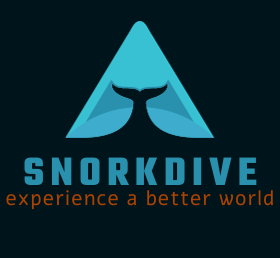People around the world call Puerto Rico “Island of Enchantment“, in Spanish- Isla del Encanto, by this nickname for a reason:
Puerto Rico is a mixture of native Taíno, Spanish, and African cultures. It is rich in unmatched cuisine, music, art, traditions, and hospitality. Exciting salsa rhythms, colorful architecture, and delicious foods reflect its vibrant blend of influences. Surrounding it all are Puerto Rico’s gorgeous white sandy beaches of the Caribbean sea and Atlantic Ocean with high rise misty green mountains. Below the surface lies a hidden underwater world waiting for you to be explored.
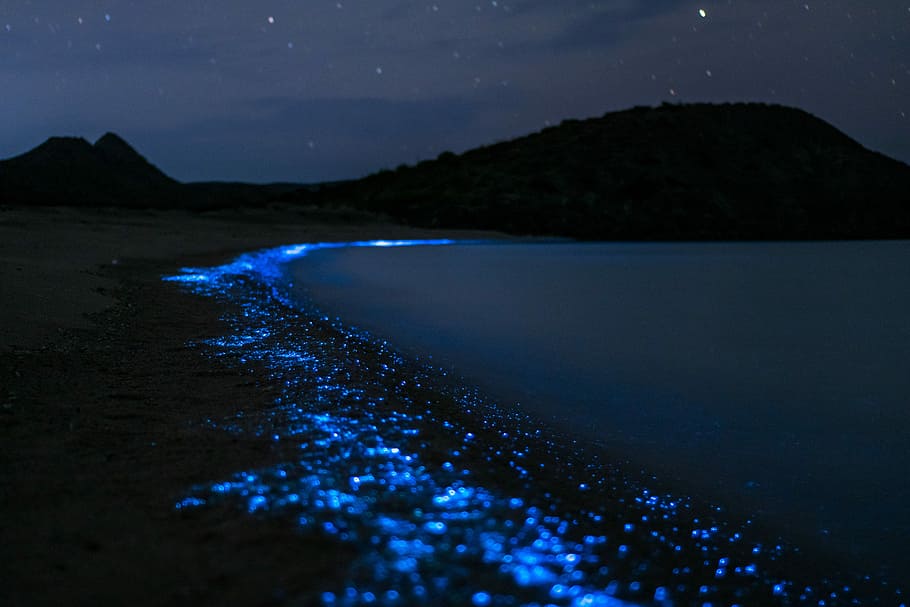
Mosquito Bay of Vieques Island is recognized as the brightest bio bay in the world by the Guinness World Records 2006.
Bio-bay or Bioluminescent Bay is one of the most beautiful phenomena on Earth, in which water area that glows at night, turning into neon blue color. Bioluminescent bays get their light from a large quantity of teeny-tiny, single-celled plankton called- dinoflagellates. Interestingly, there are only five bays in the world that qualify for it and three of them are in Puerto Rico.
Why Puerto Rico Snorkeling
Puerto Rico is a tropical heaven in the heart of the Caribbean. It has healthy vibrant coral reef systems span around its long coastline. They shelter unique ecosystems with colorful marine communities. Puerto Rico has some excellent snorkeling spots, both on the main island and on the offshore islands. Snorkeling in Puerto Rico is easily accessible even for families and kids as water is shallow and warm. You can get snorkel gear and boat tours right from the beaches. You may encounter sea turtles, starfish, octopuses, manatee, harmless reef shark (if lucky) and colorful reef fish while snorkeling here. All this make Puerto Rico one of the most incredible Snorkeling destinations in the world.
How to get to Puerto Rico:
Reaching Puerto Rico is convenient, thanks to its well-connected transportation options. Here’s a simple guide on how to get to this tropical heaven:
- By Air:
- International Flights: The main gateway is Luis Muñoz Marín International Airport (SJU) in San Juan. Direct flights operate from major U.S. cities and various international destinations.
- Domestic Flights: If you’re already in the U.S., consider direct flights from cities like Miami, New York, or Orlando. Multiple airlines offer regular services to Puerto Rico.
- The most popular route is from Miami International Airport in Florida to Luis Muñoz Marín International Airport in San Juan. On average this flight takes 2 hours 30 minutes one way and costs around $100-160 round-trip
- By Sea:
- Cruise Ships: Puerto Rico is a popular cruise destination. Several cruise lines include San Juan in their itineraries. Check cruise schedules and plan accordingly.
- Travel Documentation:
- Passport Requirements: Ensure your passport is valid, and check if you need a visa depending on your nationality. U.S. citizens do not need a passport to travel between the U.S and Puerto Rico. They only need a valid ID for entry.
Puerto Rico Snorkeling Tours
When it comes to Puerto Rico Snorkeling, there are several reputable local tour operators that can enhance your underwater experience. Here are a few well-regarded companies to consider:
- Island Kayaking Adventures:
- Website: Island Kayaking Adventures
- Services: Offers guided snorkeling tours and kayaking adventures, with a focus on exploring the bio-luminescent Mosquito Bay in Vieques.
- East Island Excursions:
- Website: East Island Excursions
- Services: Known for providing snorkeling and sailing tours to the Spanish Virgin Islands, including Culebra and its famed Flamenco Beach.
- Eco Action Tours:
- Website: Eco Action Tours
- Services: Specializes in eco-friendly tours, offering snorkeling adventures to pristine coral reefs and marine sanctuaries around Puerto Rico.
- Pure Adventure Puerto Rico:
- Website: Pure Adventure Puerto Rico
- Services: Provides snorkeling excursions, paddleboarding, and other water-based activities along the beautiful coastline of Puerto Rico.
- Snorkel PR:
- Website: Snorkel PR
- Services: Focuses exclusively on snorkeling tours, guiding participants to some of the best snorkeling spots in Puerto Rico, including Culebra and Fajardo.
Let us explore some amazing Puerto Rico snorkeling spots suitable for all ages and skill level.
How deep is Puerto Rico Snorkeling?
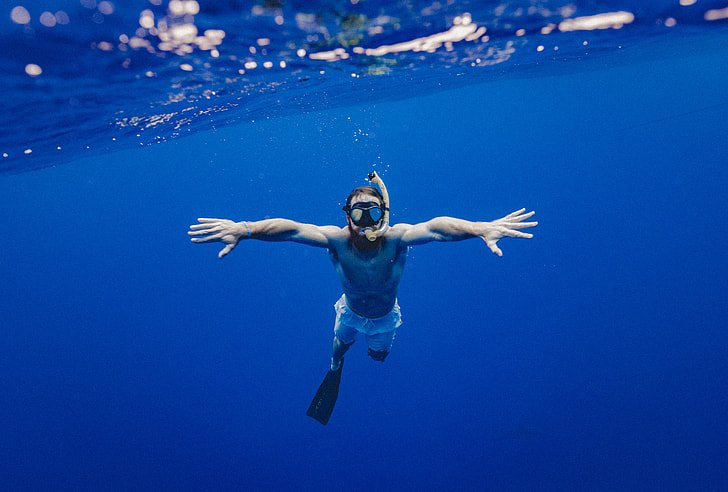
The average depth of Puerto Rico Snorkeling is about 8 to 20 feet. However, there are some areas that are much deeper. One such area is the La Parguera Natural Reserve, which has an average depth of about 40 feet.
Puerto Rico Snorkeling Map
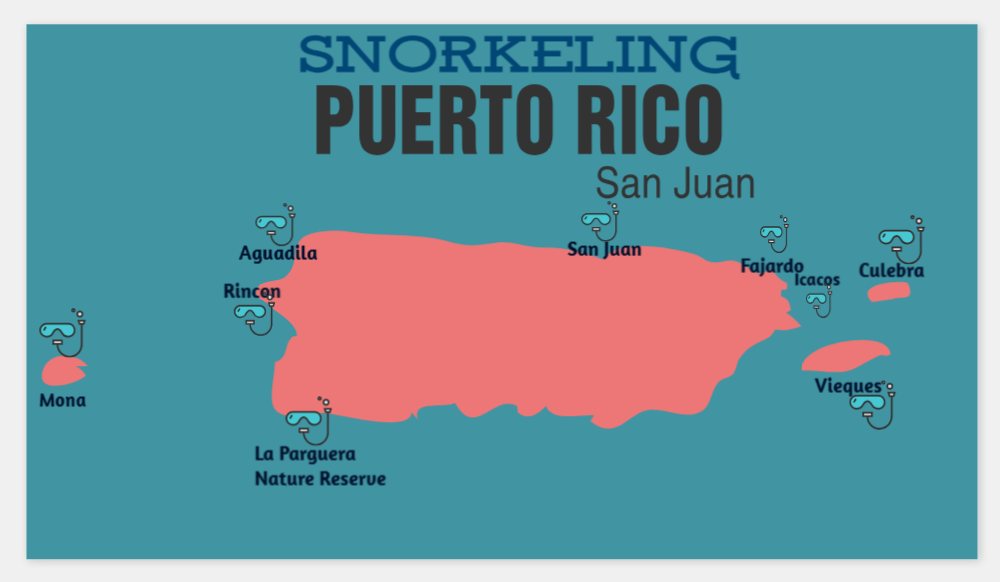
Culebra
- Culebra is a small island located 17 miles to the east of the main Island of Puerto Rico
- There are many options to get to Culebra from San Juan. Either take a flight from San Juan to the Culebra or take a private shuttle from San Juan to the Ceiba terminal, from where you can take a ferry to the Culebra
- This Island was a US naval base in the past and it has barely been touched by any modern development.
- In Culebra you won’t find any big resorts, fancy restaurants or fancy night life. It is the most ideal place for spending some quality time
- Best staying option are :El Navegante de Culebra and Oceania Villas
- Culebra flaunts with more than 12 most beautiful beaches of The Caribbean
- This island is perfect for snorkeling as water is shallow and very clean
- Most of Culebra’s snorkeling spots are easily accessible right from the beach. No need to travel by boat or kayak
- Boat tour guides and Snorkel gear rentals easily available at all beaches
- Lifeguards, bathrooms, showers, kiosks right at the beach
- Flamenco Beach and Tamarindo Beach are two must-visit snorkeling spots
Flamenco Beach
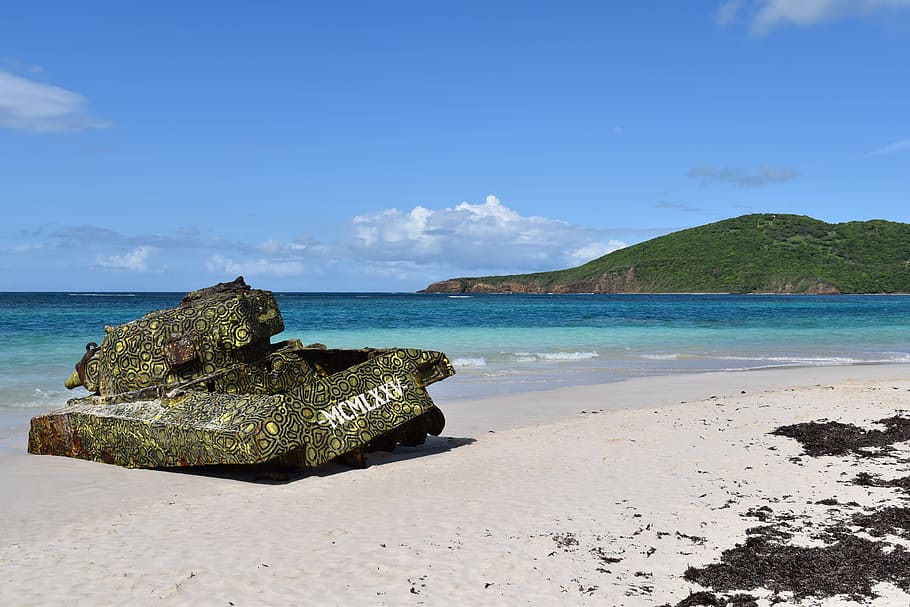
Flamenco Beach is by far the most famous spot for its wide, white powder sand and blue water. Although the reef near the main beach entrance is not very colorful or vibrant. The best snorkeling spot starts from far right of the Flamenco Beach where the sand ends and the rocks begin. This area is called Shark Cages or “Muellecito” by the locals. You can feel stronger pull while snorkeling here due to strong rip currents. You may spot sea urchins octopus, sergeant majors, stingrays and sea turtles here while snorkeling.
Facilties: bathrooms, changing rooms, showers, lifeguards, Gear rentals and parking available.
Snorkdive ratings– 3*
Tamarindo Beach
Tamarindo is golden white sandy beach with lots of colorful pebbles along the shore. This beach is popular for a breathtaking view of Cay Luis Pena. It is a prime snorkeling destination of Culebra Island as water is very calm and shallow. You may spot many Caribbean marine animals such as trumpetfish, trunkfish, octopus, squids, sea stars, stingrays and lots of sea turtles. You may even spot a harmless reef shark if you are lucky. There are no lifeguards on the beach, so never go snorkeling alone.
Facilties: No lifeguards, Parking is available outside. Gear rentals available
Snorkdive ratings– 4*
Vieques
- Vieques island is located 8 miles northeast of Puerto Rico’s mainland.
- Vieques and Culebra, together with various small islets, make up the Spanish Virgin Islands
- This island nicknamed la Isla Nena (the little girl island) by Puerto Rican poet Luis Llorens Torris. During the British colonial period its name was Crab Island.
- There are many options to get to Vieques from San Juan. Either take a flight from San Juan to the Vieques( not budget friendly) or take a private shuttle from San Juan to the Ceiba terminal, from where you can take a ferry to the Vieques.
- Vieques has more than 20 beaches with wide bays, small coves, white sand, black pebbles. you name it, Vieques has it
- Snorkelers can witness here schools of starfish, angelfish, cuttlefish, octopus, and sea turtles.
- Mosquito Bay of Vieques island is recognized as the brightest bio bay in the world by the Guinness World Records in 2006
Blue Beach (Playa La Chiva)

Playa La Chiva also known as Blue Beach is always called the best place for snorkeling in Vieques and one of the most beautiful beaches of Puerto Rico. The water is particularly shallow here, it provides excellent snorkeling conditions for kids and beginners. You can start snorkeling here right from the beach along the shore. There is surprisingly a good collection of coral and a variety of sea life that attracts underwater explorers. Advanced snorkelers can explore the tiny Isla de Chiva cay which is about 15-minute swim away from the beach and has superb snorkeling.
Facilities: bins, and restrooms available at the entrance. car parking is unsecured so don’t keep valuables in the car
Snorkdive ratings– 5*
Red Beach (Playa Caracas)
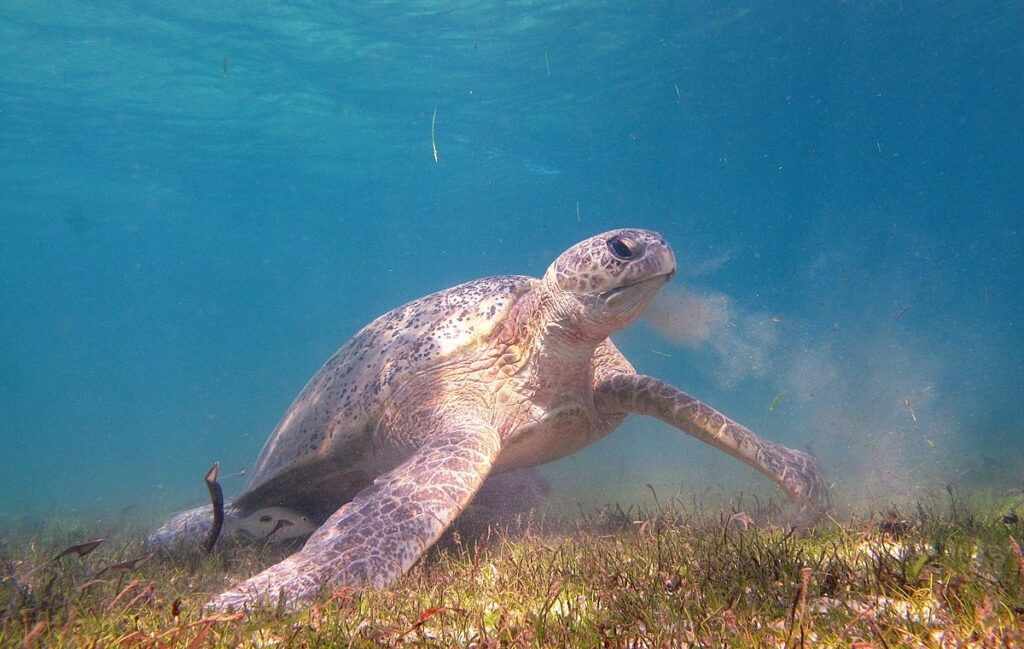
Playa Caracas also known as Red Beach is one of the beautiful beaches in the US Fish & Wildlife reserve. it is accessible by the local public transportation. It has beautiful white sand, clear Caribbean-blue water, and some picnic shelters. You can dogood snorkeling on the left side of the cove as right side of the beach is bit rocky. This is a great place to snorkel. Go to the point where the waves start crashing on the rocks. You can spot lots of colorful sea fans and many tropical fish. The wave conditions vary depending on the season.
Facilities: a large open parking area, toilet
Snorkdive ratings– 4*
Mosquito Pier
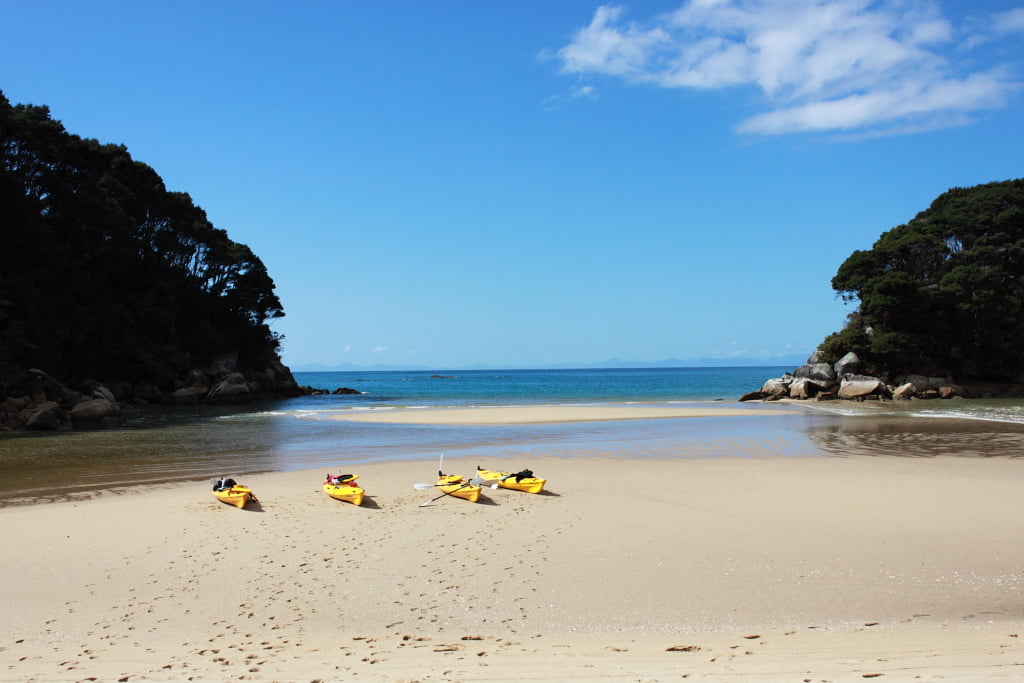
Mosquito Bay of Vieques island is recognized as the brightest bio bay in the world by the Guinness World Records. Mosquito Bay is the best-known bioluminescent bay in the world. Mosquito Bay has also been rewarded as one of the 2020s Seven Wonders of the World by Condé Nast Traveler. The Mosquito Pier is located close to the airport. The beach is a child-friendly spot with shallow waters where your little ones can do a little bit of snorkeling. Snorkelers here can witness schools of starfish, angelfish, cuttlefish, octopus, sea turtles, stingrays, and vibrant sea life.
Facilities: Free parking, toilet
Snorkdive ratings– 3.5*
Fajardo
- Fajardo is on the far eastern tip of Puerto Rico and is only about 45 minutes away from Luis Muñoz Marín International Airport (SJU) in San Juan.
- Fajardo is known as the “Town of the Tough Faces” because of how the residents fought off enemies during Spanish colonial times.
- To reach Fajardo you need to drive from San Juan, head east along the PR-66 and then follow PR-3 toward Fajardo.
- A colonial-era lighthouse in Fajardo offers breathtaking views of the Atlantic Ocean and the surrounding area.
- Fajardo is home to more than five marinas, including Puerto del Rey , which is the largest marina in the Caribbean.
- You’ll also find the Laguna Grande Bioluminescent bay, one of only five in the world. Fajardo’s Laguna Grande is the second brightest
- The water along its shores is calm and crystal clear. This sheltered strip of shoreline can get crowded on the weekends, but it’s a great place to snorkel.
- The reef system here goes from the right side of Seven Seas Bay all the way to the left side
- you can encounter some fascinating coral reef with tropical fish dolphins and lots of turtles
Seven Seas Beach

seven seas is a crescent-shaped beach lined with almond and palm trees. As a Blue Flag Beach, this is a well-maintained location. This public beach is also surrounded by little food kiosks and restaurants. Water is calm and ideal for little swimmers and those just learning to snorkel. here’s a tiny reef to the far right that flaunts with a number of fishes to watch while snorkeling.
Facilities: lifeguards picnic tables, food/drink kiosks, parking ($5), showers and toilets
Snorkdive ratings– 3.5*
Icacos
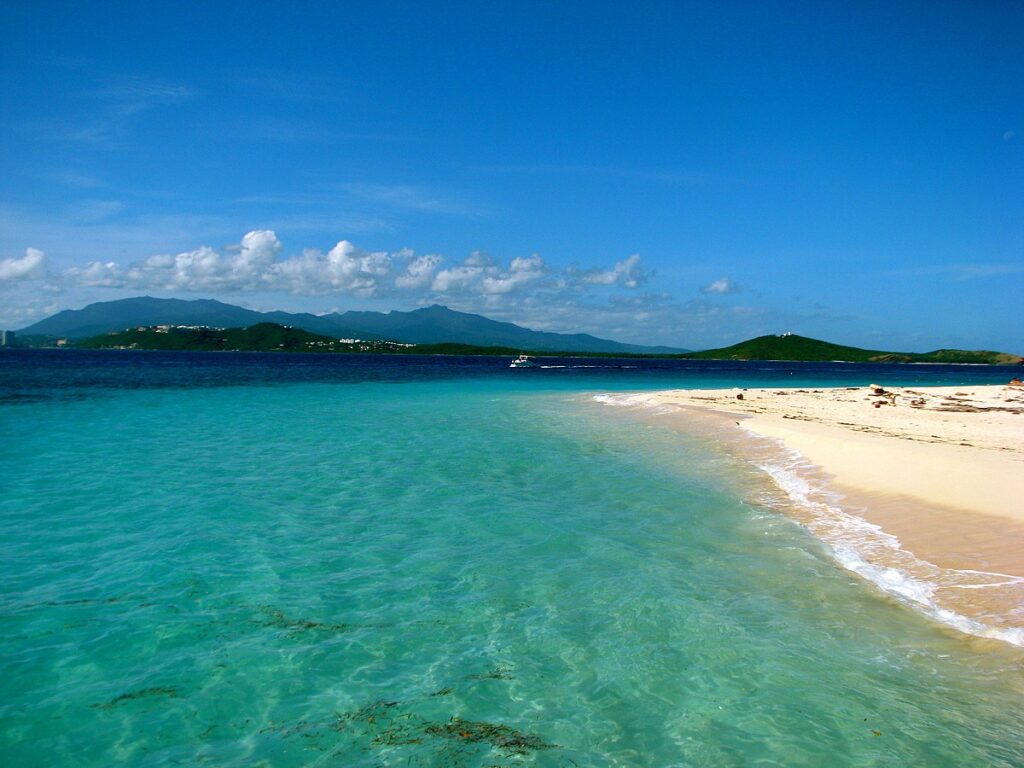
- Icacos Island is located three miles from the northeastern tip of the main island of Puerto Rico.
- It’s part of a chain of islands that runs for 18 miles creating a natural barrier between Fajardo and Culebra island
- This uninhabited Island is only accessible by boat, and there is no port or facilities on the island. So be sure to pack everything you’ll need
- Islands clear blue waters boast a diverse and abundant underwater life, making it an ideal snorkeling site
- The reef off the island’s leeward side is perfect for snorkeling—you may encounter interesting tropical fish and, if you are lucky, manta rays and even dolphins
- Icacos is Puerto Rico’s natural treasures natural reserve, so remember to keep the area clean
Snorkdive ratings– 3*
Puerto Rico Snorkeling San Juan
- Puerto Rico is surrounded by stunning beaches, and San Juan is no exception
- San Juan is renowned for its beautifully preserved historic district, known as Old San Juan
- With its colorful colonial buildings, cobblestone streets, and historic forts, such as El Morro and San Cristóbal, Old San Juan is a UNESCO World Heritage Site
- The clear waters reveal a vibrant underwater world, with schools of tropical fish, colorful coral formations, and the occasional sea turtle
- The Hawksbill, Leatherback, and Green Sea turtles are the most common nesting species in San Juan.
Escambron Beach
Escambron beach also known as Playa8 is one of the most easily accessible beaches in San Juan. This beach is divided into three beach areas with walking paths and a park connecting them all. This popular beach is protected by coral reefs that make it ideal for snorkeling. don’t expect to find large reefs or a huge variety of marine life. The Manatee Conservation Center in San Juan rehabilitates manatees that have been injured by boats or fishing nets.
Facilities: Snorkeling gear can be rented on the beach, onsite parking, shower room, toilet available
Snorkdive ratings– 3*
Agudilla
- Aguadilla is a coastal city located northwest tip of Puerto Rico, bordering the Atlantic Ocean
- Also known as “Villa del Ojo de Agua” (City of the Water spring)
- It was the site of the U.S. military’s Ramey Air Force base for almost five decades
- Aguadilla has the most beaches on the island, with nineteen in total offers
- The water along its shores is calm and crystal clear, So perfect for snorkeling with family and kids
- Aguadilla has no public transportation so prefer booking car rentals
Pena Blanca Beach
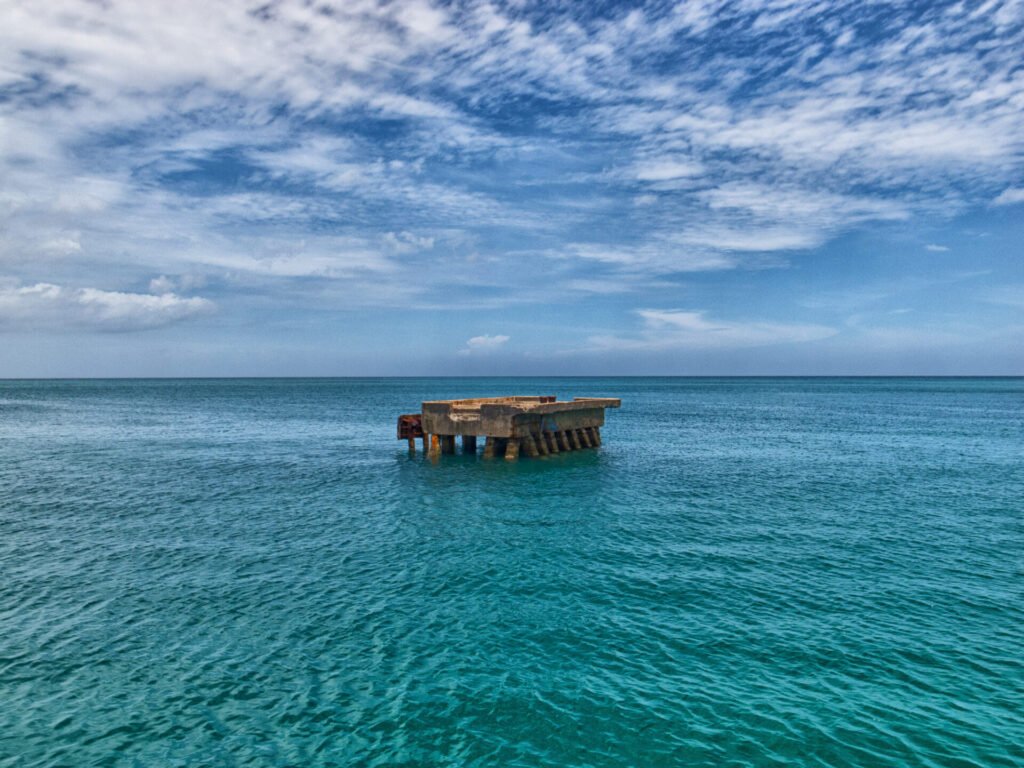
The beach with turquoise blue and crystal clear water all year around. The contrast between blue water and white sand makes this beach the most scenic beauty of Puerto Rico for snorkelers. On weekend Pena Blanca gets crowded so plan on a weekday. You may spot tropical corals, Hawksbill turtles, colorful tangs and clownfish while snorkeling. Stay away from fire coral and be careful with sea urchins. Sometimes currents can be dangerous, So stay updated about weather conditions.
Facilities: Parking space is minimal, Pay the parking fee to keep your vehicle safe, no restrooms or showers.
Snorkdive ratings– 3.5*
Crash Boat Beach

The beach gets its bizarre name because it was once used by the US military to send out boats to retrieve crashed Air Force training planes. Crash Boat Beach is located in Aguadilla and driving from San Juan, it’s a 2-hour away. This beach is considered as the party beach due to it’s accessibility for students, families, and even beginner snorkelers. you can opt this beach for local culture and more fun snorkeling. you can enjoy tropical music while snorkeling here. you need permission to use drone camera above 100ft in crash boat beach as it is closed to the Ramey Air Force Base. You may spot parrot fish, blue tang, surgeonfish, olorful tangs, clownfish and many others.
Facilities: Paid parking, no lifeguards at the beach, bathrooms, freshwater showers available.
Snorkdive ratings– 4*
Rincón
- Rincón is located on the westernmost tip of Puerto Rico and boasts with the most breathtaking twilight on the Island
- This town is also known as the town of beautiful sunsets
- There are very few snorkeling beaches but Steps Beach at Rincón is one of the best snorkeling spots on the main island of Puerto Rico.
Steps Beach
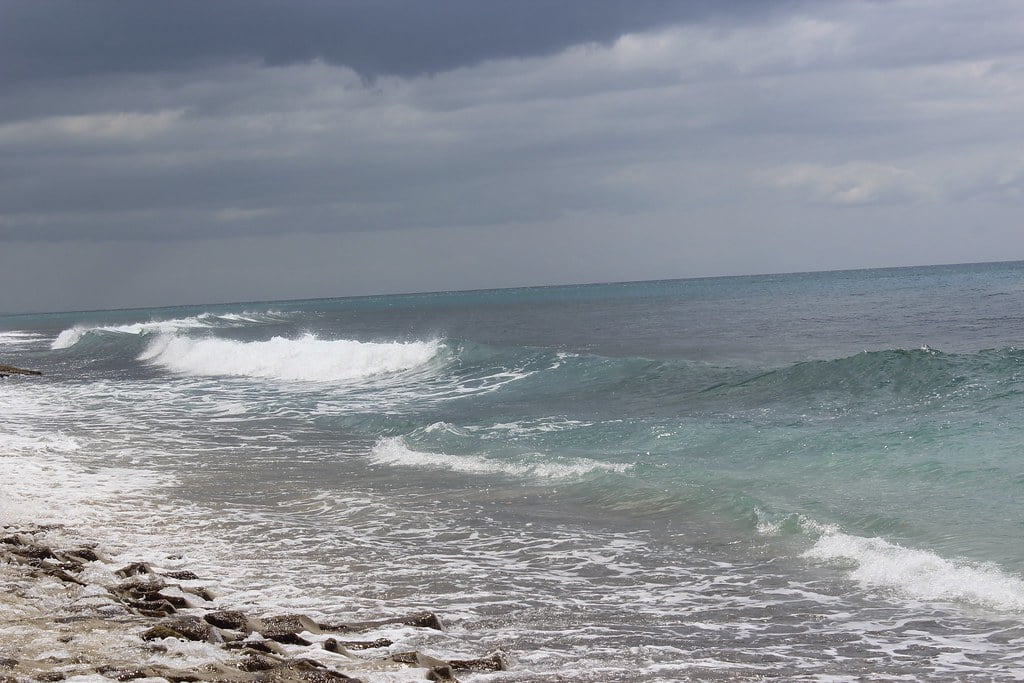
Steps Beach is officially known as “Playa Escalera Reserva Marina Tres Palmas” and offers the best snorkeling. The beach gets its popular nickname from the concrete step ruins that sit in the sand. You can start snorkeling right off the beach, straight out, slightly left from the steps. Steps beach is famous among snorkelers for its beautiful corals and diverse marine species. There are also a ton of sea fans and Elkhorn Coral. you may spot Blue Tangs, French Angelfish, Porkfish, chubs, sea turtles. In winters you may also spot migrating whales along its shores.
Facilities: Snorkeling gear can be rented on the beach, onsite parking, shower room, toilet available
Mona Island
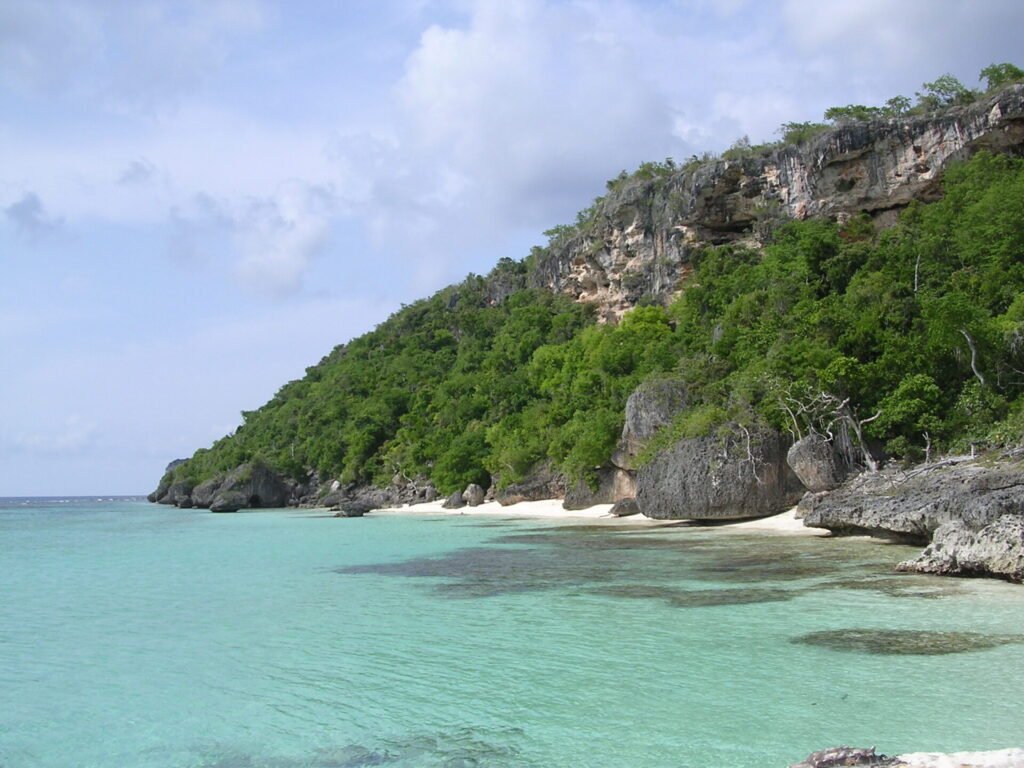
- Mona Island known as Isla de Mona is a nature reserve in Puerto Rico that is popular among tourists as “The Galapagos of the Caribbean”
- It measures about 7 miles by 4 miles in area, and lies 41 miles west of Puerto Rico’s main island
- island is recognized as one of the principal sites for hawksbill turtle nesting in the Wider Caribbean and Western Atlantic region
- Mona is home to a endangered species of prehistoric lizards called Gallinas de Palo
- visiting the island requires a permit from the Department of Natural Resources of Puerto Rico. It’s easier to go with a tour operator
- This destination is recommended for experienced divers and snorkelers, due to rough surface conditions and unpredictable currents
- The most popular beaches are Punta Arinas, Playa mujeres, Playa Serdineras and Playa Pajaros
Facilities: Uninhabited island, No facility available.
Snorkdive ratings– 2*
La Parguera
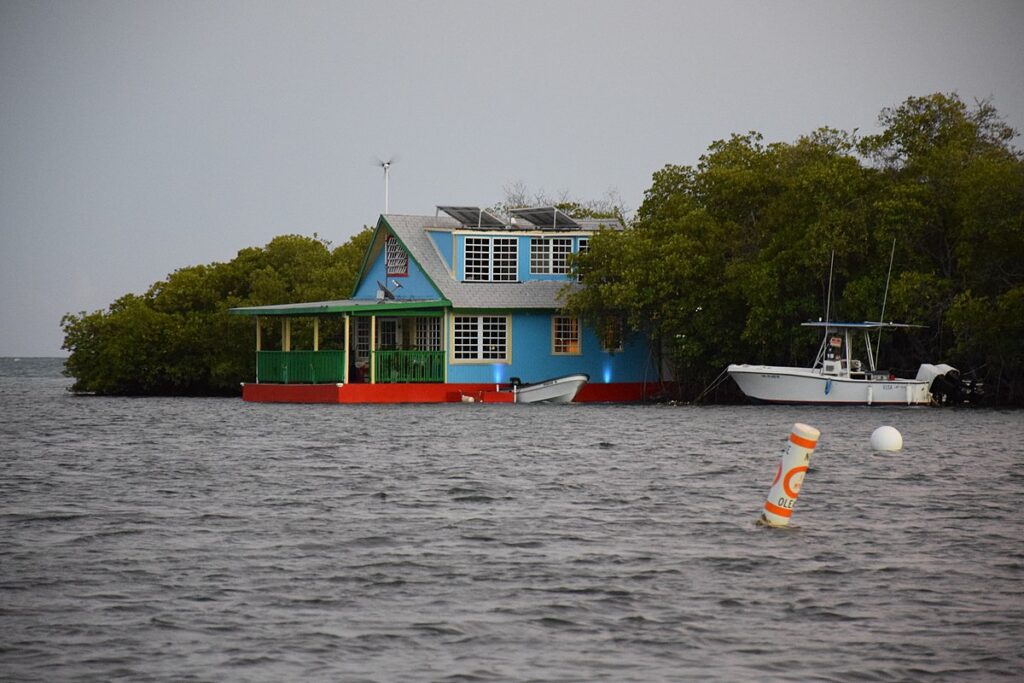
- A small village in the town of Lajas, Puerto Rico; located on the southwest coast of the island.
- La Parguera Nature Reserve is one of the most biologically diverse ecosystems in Puerto Rico.
- La Parguera doesn’t have any beaches, but instead, it is surrounded by beautiful cays.
- The area has excellent snorkeling opportunities at la Mata De la Gata, just a short boat ride from the Parguera.
- The bioluminescent bay at La Parguera is the only bio-lagoon that allows snorkeling
- La Parguera is one of Puerto Rico’s three bioluminescent bays
- Night time snorkeling of the bioluminescent bays can be a real treat.
- La Parguera has variety of reef life at such a shallow depth. Ideal snorkeling is between 10 – 25 feet depth
- You may spot some thriving populations of dolphin, barracuda, manatee and turtles along with lots of tropical fish,
Facilities: Paid parking, gear rentals available.
Snorkdive ratings– 4*
Puerto Rico Snorkeling safety-tips
- Though Puerto Rico is very safe, take normal precautions like avoiding walking alone at night, leaving valuables unattended
- Beware rip currents that can pull you offshore if you’re not a strong swimmer
- It is advisable to check local conditions, tour availability, and guidelines prior to visit
- If new to snorkeling, it’s wise to take lessons to master the skill
- Always snorkel with a buddy for mutual assistance in case of emergencies
- For responsible snorkeling keep a safe distance from marine creatures, and avoid touching or disturbing them
- Don’t make the mistake of walking on the shallow waters without paying attention. What appears to just be seagrass, may actually be young coral growing underneath.
- Corals and marine life are fragile, and contact can cause harm to the ecosystem
- Coastal deforestation is threat to sea turtle nesting
Final Words
Snorkeling in Puerto Rico offers a vibrant underwater world that shouldn’t be missed. From coral reefs and shipwrecks to Bioluminescent Bay’s glowing waters, from clean tropical waters of Culebra and Vieques to the Underwater caves of La Parguera, the Puerto Rico’s snorkeling opportunities seem endless. We hope this comprehensive guide with tips has gotten you excited to visit Puerto Rico and explore its amazing snorkeling! With so much diversity around the islands, it’s a world-class spot for underwater adventures. Please let us know if you would like us to modify or expand the conclusion further.
Frequently Asked Questions (FAQs):Puerto Rico Snorkeling
Q:When is the best time of year for Puerto Rico Snorkeling?
The best time for snorkeling in Puerto Rico is typically during the winter and spring months between December and May when the water is calmest and visibility can reach up to 100 feet in some areas.
Q: Can I snorkel in Puerto Rico if I’m a beginner?
A: Absolutely! Puerto Rico offers numerous snorkeling sites suitable for beginners, featuring calm waters and guided tours to ensure a safe and enjoyable experience.
Q: Can I encounter marine life while Puerto Rico Snorkeling?
A: Absolutely! Puerto Rico’s waters are full of marine life. Depending on the location, you may encounter colorful fish, rays, sea turtles, and various coral species
Q: Are there night snorkeling opportunities in Puerto Rico?
A: Night snorkeling is available in certain locations, Mosquito Bay in Vieques and La Parguera is renowned for its bio-luminescent bays, creating a magical night snorkeling.
Q: Can I rent snorkeling gear in Puerto Rico, or should I bring my own?
A: Both options are available. While bringing your own gear is recommended for comfort. Puerto Rico offer rental equipment also.
